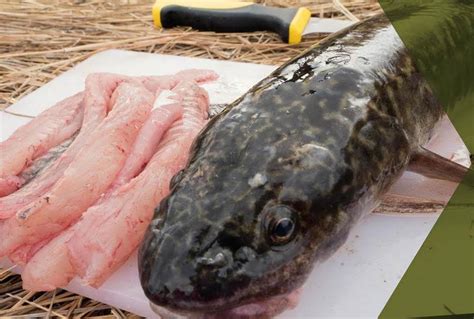
Burbot, a freshwater fish often overlooked, is gaining recognition as a delicious and affordable alternative to lobster, offering a similar taste profile at a fraction of the cost.
Burbot, a type of codfish found in freshwater environments across North America, Europe, and Asia, is emerging as a culinary star, celebrated for its delicate flavor and firm texture reminiscent of lobster. This underappreciated fish, also known as the eelpout, lingcod (though it’s not related to Pacific lingcod), or lawyer, presents a budget-friendly option for seafood enthusiasts seeking a luxurious dining experience without the hefty price tag typically associated with lobster. While lobster prices can soar, burbot remains relatively inexpensive, making it accessible to a wider range of consumers.
“Burbot is a great fish, and it’s very versatile,” says Chef Brianna Hughes, who has worked extensively with this unique fish. She highlights its mild flavor as a key attribute, noting that it can be prepared in various ways to suit different palates. Burbot’s adaptability makes it suitable for grilling, baking, frying, and even incorporating into stews and soups.
The rising popularity of burbot is not just about its affordability; it also reflects a growing interest in sustainable seafood choices. As concerns about overfishing and environmental impact continue to increase, consumers are actively seeking alternatives to popular but potentially unsustainable species. Burbot, often sourced from well-managed fisheries, presents a more environmentally responsible option for those who prioritize sustainability in their seafood consumption.
Beyond its culinary appeal, burbot also offers nutritional benefits. It is a lean source of protein, rich in omega-3 fatty acids, and contains essential vitamins and minerals. Including burbot in one’s diet can contribute to overall health and well-being.
The Allure of Burbot: A Lobster Imposter?
The primary reason for burbot’s burgeoning popularity is its taste. Many describe the flavor as subtly sweet and remarkably similar to lobster. The texture is firm and slightly bouncy, much like lobster meat, making it a convincing substitute in various dishes. This similarity allows home cooks and chefs alike to experiment with burbot in traditional lobster recipes, such as lobster rolls, bisque, and seafood salads, without breaking the bank.
Chef Hughes emphasizes the fish’s mildness, which allows it to absorb flavors from accompanying ingredients. This characteristic makes it a versatile ingredient in a range of culinary creations. From simple pan-fried preparations to more elaborate dishes, burbot’s adaptable flavor profile makes it a chef’s dream.
Geographical Distribution and Availability
Burbot thrives in cold freshwater environments, including lakes, rivers, and reservoirs. Its distribution spans across northern regions of North America, Europe, and Asia. In North America, it is commonly found in the Great Lakes, the Yukon River, and various waterways in Alaska and Canada. In Europe, it inhabits rivers and lakes in countries such as Russia, Finland, and Germany.
Despite its wide distribution, burbot is not always readily available in mainstream grocery stores. It is more likely to be found in specialty fish markets, particularly those that cater to regional or ethnic cuisines. Local fishermen and anglers are also potential sources for fresh burbot, especially in areas where it is abundant. The availability of burbot often depends on the region and the time of year, with winter months typically offering the best opportunities for sourcing this unique fish.
Culinary Applications and Preparation Methods
Burbot’s versatility extends to a wide range of culinary applications. Its mild flavor and firm texture make it suitable for various cooking methods, including grilling, baking, frying, poaching, and steaming. It can be used in soups, stews, salads, and even sushi.
-
Grilling: Burbot fillets can be grilled to perfection, resulting in a smoky flavor and crispy skin. Marinating the fillets beforehand can enhance their taste and tenderness.
-
Baking: Baking burbot with herbs, vegetables, and lemon creates a flavorful and healthy meal. The fish retains its moisture and delicate texture when baked.
-
Frying: Deep-frying or pan-frying burbot produces a crispy and golden-brown exterior while maintaining a moist interior. This method is often used in fish and chips recipes.
-
Poaching: Poaching burbot in broth or wine is a gentle cooking method that preserves its delicate flavor and texture. It is ideal for preparing burbot for salads or other cold dishes.
-
Steaming: Steaming burbot is a healthy way to cook the fish, as it requires no added fats. The fish retains its moisture and nutrients, making it a nutritious meal option.
Burbot vs. Lobster: A Cost Comparison
One of the most compelling reasons for burbot’s rise in popularity is its affordability compared to lobster. Lobster prices can fluctuate significantly depending on the season, location, and market demand. In contrast, burbot remains relatively inexpensive, making it an attractive alternative for budget-conscious consumers.
While lobster can cost upwards of $30 per pound, burbot typically retails for a fraction of that price. This price difference makes burbot accessible to a wider range of consumers, allowing them to enjoy a seafood delicacy without straining their finances. The affordability of burbot makes it an excellent option for families, individuals, and restaurants looking to offer high-quality seafood dishes at reasonable prices.
Sustainability Considerations
As concerns about overfishing and environmental impact continue to grow, consumers are increasingly seeking sustainable seafood choices. Burbot, often sourced from well-managed fisheries, presents a more environmentally responsible option compared to some other popular seafood species.
Many fisheries that harvest burbot adhere to strict regulations and management practices to ensure the long-term sustainability of the species. These practices may include catch limits, seasonal closures, and habitat protection measures. By choosing burbot from sustainable sources, consumers can support responsible fishing practices and contribute to the conservation of marine ecosystems.
Consumers can look for certifications from organizations such as the Marine Stewardship Council (MSC) to ensure that the burbot they are purchasing comes from a sustainable fishery. These certifications provide assurance that the fishery meets rigorous environmental standards.
Nutritional Profile of Burbot
Burbot is not only a delicious and affordable seafood option but also a nutritious one. It is a lean source of protein, rich in omega-3 fatty acids, and contains essential vitamins and minerals.
-
Protein: Burbot is an excellent source of high-quality protein, which is essential for building and repairing tissues, supporting immune function, and maintaining overall health.
-
Omega-3 Fatty Acids: Burbot is rich in omega-3 fatty acids, particularly EPA (eicosapentaenoic acid) and DHA (docosahexaenoic acid). These fatty acids have been linked to numerous health benefits, including reducing the risk of heart disease, improving brain function, and reducing inflammation.
-
Vitamins and Minerals: Burbot contains several essential vitamins and minerals, including vitamin D, vitamin B12, and selenium. Vitamin D is important for bone health and immune function, while vitamin B12 is necessary for nerve function and red blood cell production. Selenium is an antioxidant that helps protect cells from damage.
Preparing Burbot: Tips and Techniques
Preparing burbot is relatively simple, even for novice cooks. Its mild flavor and firm texture make it a versatile ingredient that can be cooked in various ways. Here are some tips and techniques for preparing burbot:
-
Selecting Burbot: When selecting burbot, look for fillets that are firm, moist, and have a fresh, clean smell. Avoid fillets that appear slimy or have a strong odor.
-
Skinning Burbot: Burbot skin can be tough, so it is often removed before cooking. To skin a burbot fillet, place it skin-side down on a cutting board. Hold the tail end of the fillet with one hand and use a sharp knife to separate the skin from the flesh.
-
Marinating Burbot: Marinating burbot fillets before cooking can enhance their flavor and tenderness. Marinades can be made with a variety of ingredients, such as lemon juice, olive oil, herbs, and spices.
-
Cooking Burbot: Burbot can be cooked using various methods, including grilling, baking, frying, poaching, and steaming. The cooking time will vary depending on the method and the thickness of the fillets.
-
Serving Burbot: Burbot can be served as a main course with a variety of side dishes, such as rice, vegetables, or potatoes. It can also be used in soups, stews, salads, and other dishes.
Chef’s Perspective: Brianna Hughes on Burbot
Chef Brianna Hughes’ expertise with burbot provides valuable insights into its culinary potential. She emphasizes its versatility and mild flavor, making it an ideal ingredient for various dishes.
“Burbot is a fantastic fish to work with,” says Chef Hughes. “Its mild flavor allows it to take on the flavors of whatever you’re cooking it with, and its firm texture holds up well to different cooking methods.”
Chef Hughes recommends experimenting with burbot in traditional lobster recipes, such as lobster rolls or bisque. She also suggests grilling or baking burbot with herbs and vegetables for a simple and delicious meal.
“Don’t be afraid to try new things with burbot,” encourages Chef Hughes. “It’s a very forgiving fish, and it’s hard to go wrong.”
Burbot Recipes to Try at Home
Here are a few burbot recipes to try at home:
-
Grilled Burbot with Lemon-Herb Marinade: Marinate burbot fillets in a mixture of lemon juice, olive oil, garlic, herbs, and spices. Grill the fillets over medium heat until cooked through.
-
Baked Burbot with Roasted Vegetables: Place burbot fillets on a baking sheet with roasted vegetables, such as potatoes, carrots, and onions. Bake until the fish is cooked through and the vegetables are tender.
-
Burbot Fish and Chips: Dip burbot fillets in batter and deep-fry until golden brown and crispy. Serve with French fries and tartar sauce.
-
Burbot Chowder: Add diced burbot to a creamy chowder with potatoes, onions, celery, and other vegetables. Simmer until the fish is cooked through and the vegetables are tender.
The Future of Burbot in the Culinary World
As awareness of burbot’s culinary potential grows, it is likely to become an increasingly popular seafood option. Its affordability, versatility, and sustainability make it an attractive choice for consumers and chefs alike.
With continued efforts to promote responsible fishing practices and educate consumers about the benefits of burbot, this underappreciated fish has the potential to become a staple in kitchens around the world. The rising popularity of burbot reflects a broader trend towards sustainable and affordable seafood choices, as consumers seek alternatives to overfished and expensive species. By embracing burbot and other underutilized fish, we can contribute to the health of our oceans and enjoy a diverse range of delicious and nutritious seafood options.
Frequently Asked Questions (FAQ) about Burbot
-
What does burbot taste like?
Burbot has a mild, slightly sweet flavor often compared to lobster or cod. Its texture is firm and flaky, making it a versatile fish for various culinary applications. Chef Hughes describes it as having a mild flavor which allows it to absorb flavors from accompanying ingredients.
-
Where can I find burbot?
Burbot is typically found in cold freshwater environments across North America, Europe, and Asia. It’s not commonly available in mainstream grocery stores but can be found in specialty fish markets or through local fishermen, particularly in regions where it is abundant, such as the Great Lakes or Alaska.
-
Is burbot sustainable?
Burbot can be a sustainable seafood choice when sourced from well-managed fisheries. Look for certifications like the Marine Stewardship Council (MSC) to ensure responsible fishing practices.
-
How is burbot best prepared?
Burbot is incredibly versatile. It can be grilled, baked, fried, poached, or steamed. Its mild flavor pairs well with various herbs, spices, and sauces. Chef Hughes suggests experimenting with it in lobster recipes.
-
What are the nutritional benefits of eating burbot?
Burbot is a lean source of protein, rich in omega-3 fatty acids, and contains essential vitamins and minerals like vitamin D and vitamin B12. It’s a healthy and nutritious addition to any diet.
Expanded Context and In-Depth Analysis
The emergence of burbot as a viable and desirable seafood option is indicative of several broader trends within the food industry and consumer behavior. These trends include an increasing awareness of sustainability, a growing demand for affordable alternatives to luxury ingredients, and a greater willingness to explore less common or underutilized food sources. Understanding these trends provides a richer context for appreciating the rise of the “budget-friendly lobster.”
The Sustainability Imperative:
The global seafood market is facing significant challenges related to overfishing, habitat destruction, and the environmental impacts of aquaculture. Consumers are increasingly aware of these issues and are actively seeking seafood options that are sourced sustainably. This has led to a surge in demand for certified sustainable seafood and a growing interest in species that are not as heavily exploited as popular choices like tuna, salmon, and shrimp.
Burbot, when harvested from well-managed fisheries, aligns with this sustainability imperative. Its populations in certain regions are healthy, and fishing practices are often regulated to ensure long-term viability. Choosing burbot over more vulnerable species can contribute to the overall health of marine ecosystems and support responsible fishing practices. The presence of certification programs like MSC further reinforces the sustainability credentials of certain burbot fisheries, providing consumers with a trusted way to make informed choices.
The Affordability Factor:
Economic factors also play a significant role in the rising popularity of burbot. Lobster, traditionally considered a delicacy, has become increasingly expensive due to factors such as increasing demand, fluctuating supply, and the costs associated with harvesting and transporting it. This high price point makes lobster inaccessible to many consumers, creating an opportunity for more affordable alternatives.
Burbot, with its relatively low price, offers a way to enjoy a similar culinary experience without breaking the bank. This is particularly appealing in times of economic uncertainty or when consumers are looking for ways to stretch their food budgets. The affordability of burbot allows home cooks and restaurants to incorporate seafood dishes into their menus more frequently and to experiment with different preparations without incurring excessive costs.
The Embrace of Underutilized Species:
For years, the global food system has relied on a relatively small number of plant and animal species for the majority of its food supply. This lack of diversity makes the food system more vulnerable to disruptions caused by climate change, disease, and other factors. In recent years, there has been a growing movement to promote the consumption of underutilized species, which are plants and animals that are edible but not widely consumed.
Burbot fits into this category of underutilized species. Despite its appealing taste and texture, it has historically been overlooked in favor of more popular fish. However, as consumers become more adventurous and open to trying new foods, and as chefs seek out unique ingredients to differentiate their menus, burbot is finally getting the attention it deserves. The increased availability of information about burbot, along with its promotion by chefs and food bloggers, is helping to overcome any initial hesitation that consumers may have about trying this unfamiliar fish.
The Role of Culinary Innovation:
Chefs and culinary professionals play a crucial role in shaping consumer preferences and promoting the consumption of new foods. By incorporating burbot into their menus and showcasing its versatility and deliciousness, they can help to raise awareness and generate demand for this underappreciated fish. Chef Brianna Hughes’s endorsement of burbot as a versatile and flavorful ingredient is a testament to the role that chefs can play in popularizing underutilized species.
Chefs can also experiment with different cooking methods and flavor combinations to highlight the unique qualities of burbot and to demonstrate its suitability for a wide range of dishes. By creating innovative and appealing burbot recipes, they can inspire home cooks to try cooking with this fish and to discover its culinary potential for themselves.
Challenges and Opportunities:
Despite its growing popularity, burbot still faces some challenges. One challenge is the lack of awareness among consumers. Many people have never heard of burbot and are unfamiliar with its taste and texture. Overcoming this lack of awareness requires education and promotion efforts to highlight the benefits of burbot and to encourage consumers to try it.
Another challenge is the limited availability of burbot in some regions. In areas where burbot is not commonly found, it may be difficult to source fresh or frozen fillets. Expanding the distribution of burbot and making it more accessible to consumers will be essential for its continued growth in popularity.
However, these challenges also present opportunities. Increased awareness and availability can drive demand for burbot and support the growth of sustainable fisheries. By working together, fishermen, chefs, retailers, and consumers can help to ensure that burbot becomes a widely recognized and appreciated seafood option.
In conclusion, the rise of burbot as a “budget-friendly lobster” is a reflection of broader trends towards sustainability, affordability, and the embrace of underutilized species. By understanding these trends and addressing the challenges that burbot faces, we can help to unlock its full potential and to promote a more diverse and sustainable seafood system. The increasing recognition of burbot is a positive sign that consumers are becoming more open to exploring new and underappreciated food sources, and that the food industry is responding to the growing demand for sustainable and affordable options.









